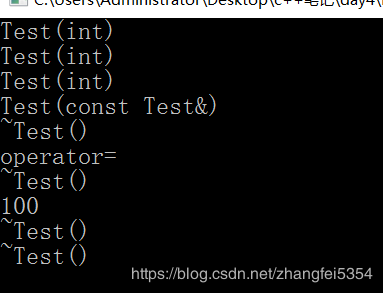一、临时量与临时对象
临时量:
- 内置类型生成的临时量是常量(临时量,寄存器带出来)。
- 自定义类型生成的临时量是变量 ,在内存中。
- 隐式生成生成的临时量是常量 ,显式生成生成的临时量是变量 。
临时对象:
临时对象是系统临时分配的对象,在没主动声明所需对象而又使用其功能时产生的
显示对象:出现类型名
隐式对象:不出现类型名
注意: 临时对象的生存周期只在本条语句,临时对象一旦被引用,它的生存周期就和引用相同。
对象如何生成?
先分配内存 在调用构造函数初始化对象的成员变量 产生对象对象析构了 对象就不存在了,对象的构造和析构是相反的。
重点:对象生成的顺序及调用的相关函数
|
1
2
3
4
5
6
7
8
9
10
11
12
13
14
15
16
17
18
19
20
21
22
23
24
25
26
27
28
29
30
31
32
|
class Test{public: Test(int a=5, int b=5):ma(a), mb(b) {cout<<"Test(int, int)"<<endl;} ~Test() {cout<<"~Test()"<<endl;} Test(const Test &src):ma(src.ma), mb(src.mb) {cout<<"Test(const Test&)"<<endl;} void operator=(const Test &src) {ma = src.ma; mb = src.mb; cout<<"operator="<<endl;}private: int ma; int mb;};Test t1(10, 10);int main(){ Test t2(20, 20); Test t3=t2; static Test t4 = Test(30, 30); t2 = Test(40, 40); t2 = (Test)(50, 50); t2 = 60; Test *p1 = new Test(70, 70); Test *p2 = new Test[2]; Test *p3 = &Test(80, 80); Test &p4 = Test(90, 90); delete p1; delete []p2;}Test t5(100, 100); |

|
1
2
3
4
5
6
7
8
9
10
11
12
13
14
15
16
17
18
19
20
21
22
23
24
25
26
27
28
29
30
|
Test(int) // Test t1(10,10); 构造t1Test(int) // Test t5(10,10); 构造t5Test(int) // Test t2(20 ,20); 构造t2Test(const Test &) // Test t3 = t2; t2拷贝构造t3Test(int) // static Test t4 = Test(30,30); 构造t4Test(int) // t2 = Test(40,40); 构造临时对象Test& operator=(const Test &) // t2 = Test(40,40); 临时对象赋值给t2~Test() // t2 = Test(40,40); 析构临时对象 Test(int) // t2 = (Test)(40,50); 构造临时对象 逗号表达式 t2 = (Test)(50) 50 , 5Test& operator=(const Test &) // t2 = (Test)(40,50); 临时对象赋值给t2 ~Test() // t2 = (Test)(40,50);析构临时对象Test(int) // t2 = 60; 构造临时对象 相当于 t2 = (Test)60;Test& operator=(const Test &) // t2 = 60; 临时对象赋值给t2~Test() // t2 = 60; 析构临时对象Test(int) // Test *p1 = new Test; 构造 TestTest(int) // Test *p2 = new Test[2]; 构造 TestTest(int) // Test *p2 = new Test[2]; 构造 TestTest(int) // Test *p3 = &Test(50,50); 构造临时对象~Test() // Test *p3 = &Test(50,50); 析构临时对象Test(int) // Test &p4 = Test(50,50); 构造临时对象~Test() // 析构p1~Test() // 析构p2 ~Test() // 析构p2 ~Test() // 析构p4指向的临时对象~Test() // 析构t3 ~Test() // 析构t2 ~Test() // 析构t4 ~Test() // 析构t5 ~Test() // 析构t1! |
二、程序优化
- 1.函数调用传对象时,按对象引用来传递,会少两个函数
- 2.函数返回对象的时候,应该返回一个临时对象,不要先定义,再返回
- 3.调用返回对象的函数时,应该以初始化的方式调用,不要以赋值的方式调用
|
1
2
3
4
5
6
7
8
9
10
11
12
13
14
15
16
17
18
19
20
21
22
23
24
25
26
27
28
29
30
31
32
33
34
35
36
37
38
39
40
41
42
43
44
45
46
|
class Test{public: Test(int data = 100) :ma(data) { cout << "Test(int)" << endl; } ~Test() { cout << "~Test()" << endl; } Test(const Test &src) :ma(src.ma) { cout << "Test(const Test&)" << endl; } Test& operator=(const Test &src) { cout << "operator=" << endl; ma = src.ma; return *this; } int getData() { return ma; }private: int ma;}; Test GetTestObject(Test t){ int value = t.getData(); Test tmp(value); return tmp; //return Test(value);}int main(){ Test t1; Test t2; t2 = GetTestObject(t1); cout << t2.getData() << endl; return 0;} |

程序分析
|
1
2
3
4
5
6
7
8
9
10
11
12
13
14
15
16
17
18
19
20
21
22
23
24
25
26
27
28
29
30
31
32
33
34
35
|
// 构造t1Test(int) // 构造t2Test(int) // GetTestObject(t1)实参t1通过值传递给Test GetTestObject(Test t) 形参 t ,调用拷贝构造Test(const Test &) //Test tmp(value); 构造对象tmpTest(int) //return tmp; 将返回值tmp拷贝构造 main函数栈栈上的临时对象Test(const Test&) // 析构tmp~Test() // 析构形参 t~Test() // t2 = GetTestObject(t1); 临时对象调用赋值函数赋值给t2operator= // 析构临时对象~Test() // 打印 ma100 // 析构t2~Test() // 析构t1~Test() |
优化1:函数调用传对象时,按对象引用来传递,会少两个函数
|
1
2
3
4
5
6
|
Test GetTestObject(Test &t){ int value = t.getData(); Test tmp(value); return tmp;} |

优化2:函数返回对象的时候,应该返回一个临时对象,不要先定义,再返回
|
1
2
3
4
5
6
7
|
Test GetTestObject(Test &t){ int value = t.getData(); /*Test tmp(value); return tmp;*/ return Test(value);} |

优化3:调用返回对象的函数时,应该以初始化的方式调用,不要以赋值的方式调用
|
1
2
3
4
5
6
7
8
9
10
11
|
int main(){ Test t1; Test t2 = GetTestObject(t1); //t2 = GetTestObject(t1); cout << t2.getData() << endl; return 0;} |

以上所述是小编给大家介绍的C++ 临时量与临时对象及程序的相关优化详解整合,希望对大家有所帮助,如果大家有任何疑问请给我留言,小编会及时回复大家的。在此也非常感谢大家对服务器之家网站的支持!














